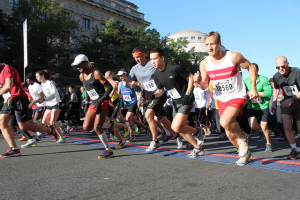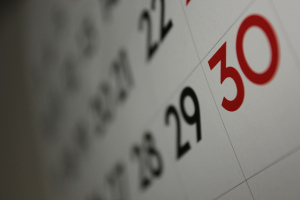3.4: Introducing the 2008 Physical Activity Guidelines for Americans
- Page ID
- 38980
Being physically active is one of the most important steps that Americans of all ages can take to improve their health. This inaugural Physical Activity Guidelines for America ns provides science-based guidance to help Americans aged 6 and older improve their health through appropriate physical activity. The U.S. Department of Health and Human Services (HHS) issues the Physical Activity Guidelines for Americans. The content of the Physical Activity Guidelines complements the Dietary Guidelines for Americans, a joint effort of HHS and the U.S. Department of Agriculture (USDA). Together, the two documents provide guidance on the importance of being physically active and eating a healthy diet to promote good health and reduce the risk of chronic diseases. This chapter provides background information about the rationale and process for developing the Guidelines. It then discusses several issues that provide the framework for understanding the Guidelines. The chapter also explains how these Guidelines fit in with other published physical activity recommendations and how they should be used in practice.
ns provides science-based guidance to help Americans aged 6 and older improve their health through appropriate physical activity. The U.S. Department of Health and Human Services (HHS) issues the Physical Activity Guidelines for Americans. The content of the Physical Activity Guidelines complements the Dietary Guidelines for Americans, a joint effort of HHS and the U.S. Department of Agriculture (USDA). Together, the two documents provide guidance on the importance of being physically active and eating a healthy diet to promote good health and reduce the risk of chronic diseases. This chapter provides background information about the rationale and process for developing the Guidelines. It then discusses several issues that provide the framework for understanding the Guidelines. The chapter also explains how these Guidelines fit in with other published physical activity recommendations and how they should be used in practice.
Why and How the Guidelines Were Developed
The Rationale for Physical Activity Guidelines
We clearly know enough now to recommend that all Americans should engage in regular physical activity to improve overall health and to reduce risk of many health problems. Physical activity is a leading example of how lifestyle choices have a profound effect on health. The choices we make about other lifestyle factors, such as diet, smoking, and alcohol use, also have important and independent effects on our health.
The primary audiences for the Physical Activity Guidelines for Americans are policymakers and health professionals. The Guidelines are designed to provide information and guidance on the types and amounts of physical activity that provide substantial health benefits. This information may also be useful to interested members of the public. The main idea behind the Guidelines is that regular physical activity over months and years can produce long-term health benefits. Realizing these benefits requires physical activity each week.
These Guidelines are necessary because of the importance of physical activity to the health of Americans, whose current inactivity puts them at unnecessary risk. Healthy People 2010 set objectives for increasing the level of physical activity in Americans over the decade from 2000 to 2010. Unfortunately, the latest information shows that inactivity among American adults and youth remains relatively high and that little progress has been made in meeting these objectives.
The Development of the Physical Activity Guidelines for Americans
Since 1995 the Dietary Guidelines for Americans has included advice on physical activity. However, with the development of a firm science base on the health benefits of physical activity, HHS began to consider whether separate physical activity guidelines were appropriate. With the help of the Institute of Medicine, HHS convened a workshop in October 2006 to address this question. The workshop’s report, Adequacy of Evidence for Physical Activity Guidelines Development (http://www.nap.edu/catalog.php?record_id=11819), affirmed that advances in the science of physical activity and health justified the creation of separate physical activity guidelines.
The steps used to develop the Physical Activity Guidelines for Americans were similar to those used for the Dietary Guidelines for Americans. In 2007 HHS Secretary Mike Leavitt appointed an external scientific advisory committee called the Physical Activity Guidelines Advisory Committee. The Advisory Committee conducted an extensive analysis of the scientific information on physical activity and health. The Physical Activity Guidelines Advisory Committee Report, 2008 and meeting summaries are available at http://www.health.gov/PAGuidelines/.
HHS primarily used the Advisory Committee’s report but also considered comments from the public and Government agencies when writing the Guidelines. The Guidelines will be widely promoted through various communications strategies, such as materials for the public, Web sites, and partnerships with organizations that promote physical activity.
The Framework for the Physical Activity Guidelines for Americans
The Advisory Committee report provided the content and conceptual underpinning for the Guidelines. The main elements of this framework are described in the following sections.
Baseline Activity Versus Health-Enhancing Physical Activity
Physical activity has been defined as any bodily movement produced by the contraction of skeletal muscle that increases energy expenditure above a basal level. However, in this document, the term “physical activity” will generally refer to bodily movement that enhances health. Bodily movement can be divided into two categories:
- Baseline activity refers to the light-intensity activities of daily life, such as standing, walking slowly, and lifting lightweight objects. People vary in how much baseline activity they do. People who do only baseline activity are considered to be inactive. They may do very short episodes of moderate- or vigorous-intensity activity, such as climbing a few flights of stairs, but these episodes aren’t long enough to count toward meeting the Guidelines. The Guidelines don’t comment on how variations in types and amounts of baseline physical activity might affect health, as this was not addressed by the Advisory Committee report.
- Health-enhancing physical activity is activity that, when added to baseline activity, produces health benefits. In this document, the term “physical activity” generally refers to health-enhancing physical activity. Brisk walking, jumping rope, dancing, lifting weights, climbing on playground equipment at recess, and doing yoga are all examples of physical activity. Some people (such as postal carriers or carpenters on construction sites) may get enough physical activity on the job to meet the Guidelines.
We don’t understand enough about whether doing more baseline activity results in health benefits. Even so, efforts to promote baseline activities are justifiable. After all, baseline activities are normal lifestyle activities. Encouraging Americans to increase their baseline activity is sensible for several reasons:
- Increasing baseline activity burns calories, which can help in maintaining a healthy body weight.
- Some baseline activities are weight-bearing and may improve bone health.
- There are reasons other than health to encourage more baseline activity. For example, walking short distances instead of driving can help reduce traffic congestion and the resulting air pollution.
- Encouraging baseline activities helps build a culture where physical activity in general is the social norm.
- Short episodes of activity are appropriate for people who were inactive and have started to gradually increase their level of activity, and for older adults whose activity may be limited by chronic conditions.
The availability of infrastructure to support short episodes of activity is therefore important. For example, people should have the option of using sidewalks and paths to walk between buildings at a worksite, rather than having to drive. People should also have the option of taking the stairs instead of using an elevator.
Health Benefits Versus Other Reasons To Be Physically Active
 Although the Guidelines focus on the health benefits of physical activity, these benefits are not the only reason why people are active. Physical activity gives people a chance to have fun, be with friends and family, enjoy the outdoors, improve their personal appearance, and improve their fitness so that they can participate in more intensive physical activity or sporting events. Some people are active because they feel it gives them certain health benefits (such as feeling more energetic) that aren’t yet conclusively proven for the general population.
Although the Guidelines focus on the health benefits of physical activity, these benefits are not the only reason why people are active. Physical activity gives people a chance to have fun, be with friends and family, enjoy the outdoors, improve their personal appearance, and improve their fitness so that they can participate in more intensive physical activity or sporting events. Some people are active because they feel it gives them certain health benefits (such as feeling more energetic) that aren’t yet conclusively proven for the general population.
The Guidelines encourage people to be physically active for any and all reasons that are meaningful for them. Nothing in the Guidelines is intended to mean that health benefits are the only reason to do physical activity.
Focus on Disease Prevention
The Guidelines focus on preventive effects of physical activity, which include lowering the risk of developing chronic diseases such as heart disease and type 2 diabetes.
Physical activity also has beneficial therapeutic effects and is commonly recommended as part of the treatment for medical conditions. The Advisory Committee report did not review the therapeutic effects of activity, and the Guidelines do not discuss the use of physical activity as medical treatment.
Health-Related Versus Performance-Related Fitness
The Guidelines focus on reducing the risk of chronic disease and promoting health-related fitness, particularly cardiovascular and muscular fitness. People can gain this kind of fitness by doing the amount and types of activities recommended in the Guidelines.
The Guidelines do not address the types and amounts of activity necessary to improve performance-related fitness. Athletes need this kind of fitness when they compete. Medical screening issues for competitive athletes also are outside the scope of the Guidelines.
People who are interested in training programs to increase performance-related fitness should seek advice from other sources. Generally, these people do much more activity than required to meet the Guidelines.
Lifespan Approach
The best way to be physically active is to be active for life. Therefore, the Guidelines take a lifespan approach and provide recommendations for three age groups: Children and Adolescents, Adults, and Older Adults.
The Physical Activity Guidelines are for Americans aged 6 and older. The Advisory Committee report did not review evidence for children younger than age 6. Physical activity in infants and young children is, of course, necessary for healthy growth and development. Children younger than 6 should be physically active in ways appropriate for their age and stage of development.
Individualized Health Goals
The Guidelines generally explain the amounts and types of physical activity needed for health benefits.
Within these overall parameters, individuals have many choices about appropriate types and amounts of activity.
To make these choices, American adults need to set personal goals for physical activity. Setting these goals involves questions like, “How physically fit do I want to be?” “How important is it to me to reduce my risk of heart disease and diabetes?” “How important is it to me to reduce my risk of falls and hip fracture?” “How much weight do I want to lose and keep off?”
People can meet the Guidelines and their own personal goals through different amounts and types of activity. Written materials, health-care providers, and fitness professionals can provide useful information and help people set and carry out specific goals.
Four Levels of Physical Activity
The Advisory Committee report provides the basis for dividing the amount of aerobic physical activity an adult gets every week into four categories: inactive, low, medium, and high (see table below). This classification is useful because these categories provide a rule of thumb of how total amount of physical activity is related to health benefits. Low amounts of activity provide some benefits; medium amounts provide substantial benefits; and high amounts provide even greater benefits.
Classification of Total Weekly Amounts of Aerobic Physical Activity Into Four Categories
Levels of Physical Activity | Range of Moderate-Intensity Minutes a Week | Summary of Overall Health Benefits | Comment |
Inactive | No activity beyond baseline | None | Being inactive is unhealthy. |
Low | Activity beyond baseline but fewer than 150 minutes a week | Some | Low levels of activity are clearly preferable to an inactive lifestyle. |
Medium | 150 minutes to 300 minutes a week | Substantial | Activity at the high end of this range has additional and more extensive health benefits than activity at the low end. |
High | More than 300 minutes a week | Additional | Current science does not allow researchers to identify an upper limit of activity above which there are no additional health benefits. |
- Inactive is no activity beyond baseline activities of daily living.
- Low activity is activity beyond baseline but fewer than 150 minutes (2 hours and 30 minutes) of moderate-intensity physical activity a week or the equivalent amount (75 minutes, or 1 hour and 15 minutes) of vigorous-intensity activity.
- Medium activity is 150 minutes to 300 (5 hours) minutes of moderate-intensity activity a week (or 75 to 150 minutes of vigorous-intensity physical activity a week). In scientific terms, this range is approximately equivalent to 500 to 1,000 metabolic equivalent (MET) minutes a week.
- High activity is more than the equivalent of 300 minutes of moderate-intensity physical activity a week.
For More Information Appendix 1 provides a detailed explanation of MET-minutes, a unit useful for describing the energy expenditure of a specific physical activity.
Relationship to Previous Public Health Recommendations
In 1995 the Centers for Disease Control and Prevention (CDC) and the American College of Sports Medicine (ACSM) published physical activity recommendations for public health. The report stated that adults should accumulate at least 30 minutes a day of moderate-intensity physical activity on most, preferably all, days per week. In 1996 Physical Activity and Health: A Report of the Surgeon General supported this same recommendation.
physical activity on most, preferably all, days per week. In 1996 Physical Activity and Health: A Report of the Surgeon General supported this same recommendation.
In order to track the percentage of adults who meet this guideline, CDC specified that “most” days per week was 5 days. Since 1995 the common recommendation has been that adults obtain at least 30 minutes of moderate-intensity physical activity on 5 or more days a week, for a total of at least 150 minutes a week.
The Physical Activity Guidelines for Americans affirms that it is acceptable to follow the CDC/ACSM recommendation and similar recommendations. However, according to the Advisory Committee report, the CDC/ACSM guideline was too specific. In other words, existing scientific evidence does not allow researchers to say, for example, whether the health benefits of 30 minutes on 5 days a week are any different from the health benefits of 50 minutes on 3 days a week. As a result, the new Guidelines allow a person to accumulate 150 minutes a week in various ways.
Putting the Guidelines Into Practice
Although the Advisory Committee did not review strategies to promote physical activity, action is needed at the individual, community, and societal levels to help Americans become physically active. Publications such as the Guide to Community Preventive Services (www.thecommunityguide.org/pa/) and the recommendations of the U.S. Preventive Services Task Force (http://www.ahrq.gov/clinic/cps3dix.htm) summarize evidence-based strategies for promoting physical activity on the community level and through primary health care. Accordingly, the final chapter of the Physical Activity Guidelines for Americans provides only a brief discussion on promoting physical activity, and indicates how to link the Guidelines to action strategies.
Assessing Whether Physical Activity Programs Are Consistent With the Guidelines
Programs that provide opportunities for physical activity, such as classes or community activities, can help people meet the Guidelines. These programs do not have to provide all, or even most, of the recommended weekly activity. For example, a mall walking program for older adults may meet only once a week yet provide useful amounts of activity, as long as people get the rest of their weekly recommended activity on other days.
Programs that are consistent with the Guidelines:
- Provide advice and education consistent with the Guidelines;
- Add episodes of activity that count toward meeting the Guidelines; and
- May also include activities, such as stretching or warming up and cooling down, whose health benefits are not yet proven but that are often used in effective physical activity programs.
The Importance of Understandable Guidelines
HHS has tried to keep the Physical Activity Guidelines straightforward and clear, while remaining consistent with complex scientific information. In each chapter the key Guidelines are set apart from the text, in order to identify the most important information to communicate to the public. The messages contained in these Guidelines should be disseminated to the general public and to anyone involved in promoting physical activity.
- Image of runners. Authored by: Elvert Barnes. Located at: https://flic.kr/p/h1oJ27. License: CC BY-SA: Attribution-ShareAlike
- Image of kite flying. Authored by: Brett Davies. Located at: https://flic.kr/p/fLrSXu. License: CC BY-NC-SA: Attribution-NonCommercial-ShareAlike
- Image of calendar. Authored by: Dafne Cholet. Located at: https://flic.kr/p/9bUbH3. License: CC BY: Attribution
- Lifetime Fitness and Wellness. Provided by: Extended Learning Institute of Northern Virginia Community College. Located at: https://eli.nvcc.edu/. License: CC BY: Attribution
- Chapter 1 2008 Physical Activity Guidelines for Americans. Provided by: U.S. Department of Health and Human Services. Located at: http://health.gov/paguidelines/guidelines/. License: Public Domain: No Known Copyright

